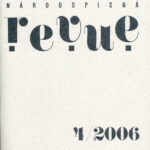The Ethnographic Revue 4/2006 pays its attention to toys and playing. Zdeňka Poláková (About Toys, Games and Playing) gives her opinion on that theme within more general context. Alena Křížová (From a Toy to a Souvenir) deals with a toy as an artistic artefact. Two essays have their roots in the ethnographic region of Valašsko: Michal Roček (The Tradition of the Smudgy Toys ́ Manufacture) prepared an article concerning the phenomenon of the smudgy toys, Václav Michalička (The Children’s Whip – a Toy and an Implement of Work) wrote the text about children’s whips. Jana Poláková (How Do the Romany Children Play? – Notes from a terrain research at Rudňany) pays her attention to Romany children.
The section “The Transformation of Traditions” brings an article “Christmas as an Invented Tradition or Ambivalent Ritual?” by Eva Jirková and Marta Ulrychová. The social chronicle remembers the anniversaries of the musicologist Jan Trojan (born 1926), the ethnologist Miloslava Hošková (born 1946) and the choreologist Eva Kröschlová (born 1926). The obituary articles are devoted to the musician Otakar Pokorný (1926-2006) and the ethnologist Richard Jeřábek (1931- 2006). Into other regular sections, the reports of conferences, exhibitions, festivals and ethnographic activities and reviews of new editions have been involved.
About Toys, Games and Playing
The history of playing reaches back to the primeval times – the oldest maintained toys of the provable origin come from the primeval civilizations. Since the Classical times, the attention was paid to the meaning of playing and the possibilities of its didactic mission. Those tendencies were developed by medieval and modern philosophers and pedagogues. The 18th century brought an important positive change in views of the importance of toys and their affection with upbringing and education, which is reflected in the production of many new types. In the 19th and especially in the 20th century, these questions were observed within a lot of scientific branches systematically – both its positive and negative trends and affects.
From a Toy to a Souvenir
The tradition of home fabrication of the so-called folk toy is quite short in the Czech Republic. Their beginnings go back to the 1830s. The toy designs resulting from the folk models became subjects at professional schools and even a subject of interest of the artists, who tried to create a so-called artistic toy, which should become a part of child’s esthetical upbringing. That artistic toy, however, did often not comply with the demands made on a children’s toy. Its criterion was mainly the artistic quality, so it moved to the roll of a gift or souvenir subject. Small workshops or home artisans who were affected retroactively realized the artistic designs – they took part in lessons and presented their products at exhibitions. Therefore, it is difficult or even impossible to earmark the category of a “folk toy” from the category of a “craft” or “artistic” toy.
The Tradition of the Smudgy Toys ́ Manufacture
The so-called smudgy toys were made only in some villages in Moravia. Valašská Bystřice was the most importance centre of this manufacture, which was supported by the considerably wooded location with suitable wood. The typical way of manufacture was a feature of the “smudgy” toy. The manufacturers smoked the toys in a furnace. The wood surface turned brown to black. This basic act was done for aesthetic reasons. After that, different patterns were cut in the wood surface by tools. In this way, the natural color was laid bare and the decorative contrast came out. Nowadays, the knowledge of this technology wastes away and only a few persons know the manufacture sequence.
The Children’s Whip – a Toy and an Implement of Work
In the past, children’s whip was an indispensable toy to the most country boys. The whip fulfilled also the function of a work implement used for keeping poultry and cattle out at grass. The boys ́ play with a whip meant especially development of skill needful for farming. Besides the whips made by the children themselves, also manufactured whips used to be sell. The village of Metylovice (District of Frýdek-Místek) took an essential position in the manufacture of whips. Many people dealt with leather manufacture. Here were made children’s whips with a leather strap decorated with a tassel, and with a wooden handle, which used to have a coloured décor with impressive patterns. The manufacture of children’s whips in Metylovice ceased to exist in the 1950s.
How Do the Romany Children Play? – Notes from a terrain research at Rudňany
The essay results the terrain research in the village of Rudňany, which was done by the workers of the Museum of Roma Culture. It was found out that the Romany children have fewer opportunities for they games, than the children of majority society have. It is caused mainly by the social conditions of their families and division of housework among individual family members. The children up to the age of about 9 years play together; later, the groups according to sex develop. The Romany children like playing at being “mothers and fathers” and they love motion games. For most amusements, they utilize modest means of their environment, which forces them to involve their imagination more extensively, than the Romany children from town agglomerations do.



